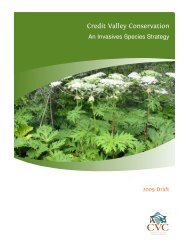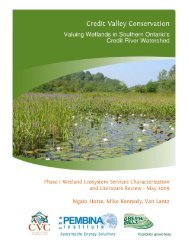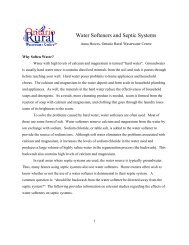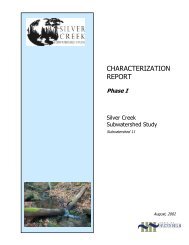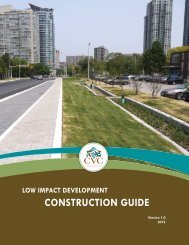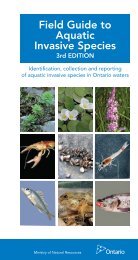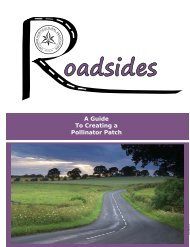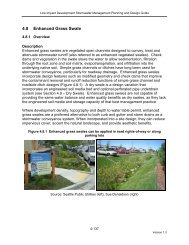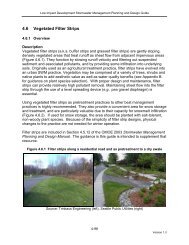Plants of the Credit River Watershed - Credit Valley Conservation
Plants of the Credit River Watershed - Credit Valley Conservation
Plants of the Credit River Watershed - Credit Valley Conservation
You also want an ePaper? Increase the reach of your titles
YUMPU automatically turns print PDFs into web optimized ePapers that Google loves.
The following definitions have been provided to help better understand <strong>the</strong><br />
information contained in <strong>the</strong> tables <strong>of</strong> vascular plants for <strong>the</strong> watershed.<br />
Rarity Codes<br />
G-Rank<br />
A network <strong>of</strong> natural heritage programs, scientific experts and The Nature Conservancy<br />
develops G-Rank or global ranks. The ranking is based on <strong>the</strong> range-wide status <strong>of</strong> a<br />
species, subspecies or variety.<br />
Codes<br />
G1 Extremely Rare; usually 5 or fewer occurrences in <strong>the</strong> overall range or very few<br />
remaining individuals; or because <strong>of</strong> some factor(s) making it especially<br />
vulnerable to extinction.<br />
G2 Very Rare; usually between 5 and 20 occurrences in <strong>the</strong> overall range or with<br />
many individuals in fewer occurrences; or because <strong>of</strong> some factor(s) making it<br />
vulnerable to extinction.<br />
G3 Rare to uncommon; usually between 20 and 100 occurrences; may have fewer<br />
occurrences, but with a large number <strong>of</strong> individuals in some populations; may be<br />
susceptible to large-scale disturbances.<br />
G4 Common; usually more than 100 occurrences; usually not susceptible to<br />
immediate threats.<br />
G5 Very common; demonstrable secure under present conditions.<br />
GU Status uncertain; <strong>of</strong>ten because <strong>of</strong> low search efforts or cryptic nature <strong>of</strong> <strong>the</strong><br />
species; more data needed.<br />
G? Unranked; or, if following a ranking, rank tentatively assigned (e.g. G3?)<br />
G A “G” (or “T”) followed by a blank space means that <strong>the</strong> NHIC has not yet<br />
obtained <strong>the</strong> Global Rank from <strong>the</strong> Nature Conservancy.<br />
Q Denotes that <strong>the</strong> taxonomic status <strong>of</strong> <strong>the</strong> species, subspecies, or variety is<br />
questionable.<br />
T Denotes that <strong>the</strong> rank applies to a subspecies or variety.<br />
KEY TO TABLES<br />
S-Rank<br />
S-Rank - are provincial ranks (or Sub national ranks) that are used by <strong>the</strong> Natural Heritage<br />
Information Centre to set protection priorities for rare species and natural communities.<br />
The ranks are assigned based upon recent records.<br />
Codes<br />
S1 Extremely Rare; usually 5 or fewer occurrences in <strong>the</strong> province or very few<br />
remaining individuals; <strong>of</strong>ten especially vulnerable to extirpation.<br />
S2 Very Rare; usually between 5 and 20 occurrences in <strong>the</strong> province or with many<br />
individuals in fewer occurrences; <strong>of</strong>ten susceptible to extirpation.<br />
S3 Rare to Uncommon; usually between 20 and 100 occurrences in <strong>the</strong> province;<br />
may have fewer occurrences, but with a large number <strong>of</strong> individuals in some<br />
populations; may be susceptible to large-scale disturbances.<br />
S4 Common; usually more than 100 occurrences; usually not susceptible to<br />
immediate threats.<br />
S5 Very Common; demonstrably secure under present conditions.<br />
SE Exotic. Not believed to be a part <strong>of</strong> Ontario’s natural flora.<br />
SH Historical; <strong>of</strong> only historical occurrence in <strong>the</strong> province (no occurrences<br />
verified in <strong>the</strong> past 20 years), but with expectation that it may still be extant.<br />
C Captive/Cultivated; existing in <strong>the</strong> province only in a cultivated state;<br />
introduced population may not yet be fully established.<br />
The provincial ranking, <strong>the</strong> “S-Rank,” is an estimate <strong>of</strong> <strong>the</strong> abundance for each plant and<br />
should not be confused with <strong>the</strong> rarity designation, although <strong>the</strong>re is a relationship between<br />
<strong>the</strong> two. As presently treated, any plant with an S-Rank <strong>of</strong> S1, S2 or S3 is designated<br />
provincially rare.



